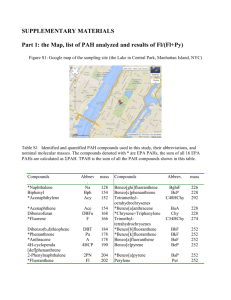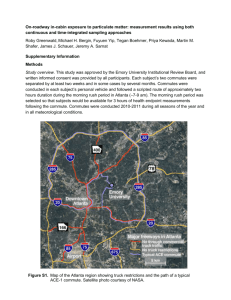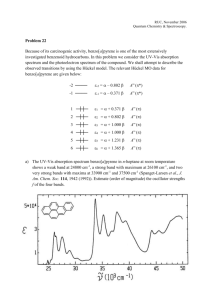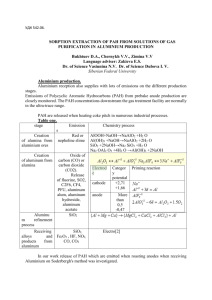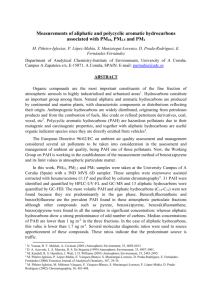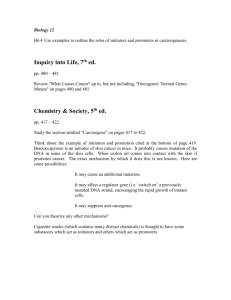C. Reagents and Materials
advertisement
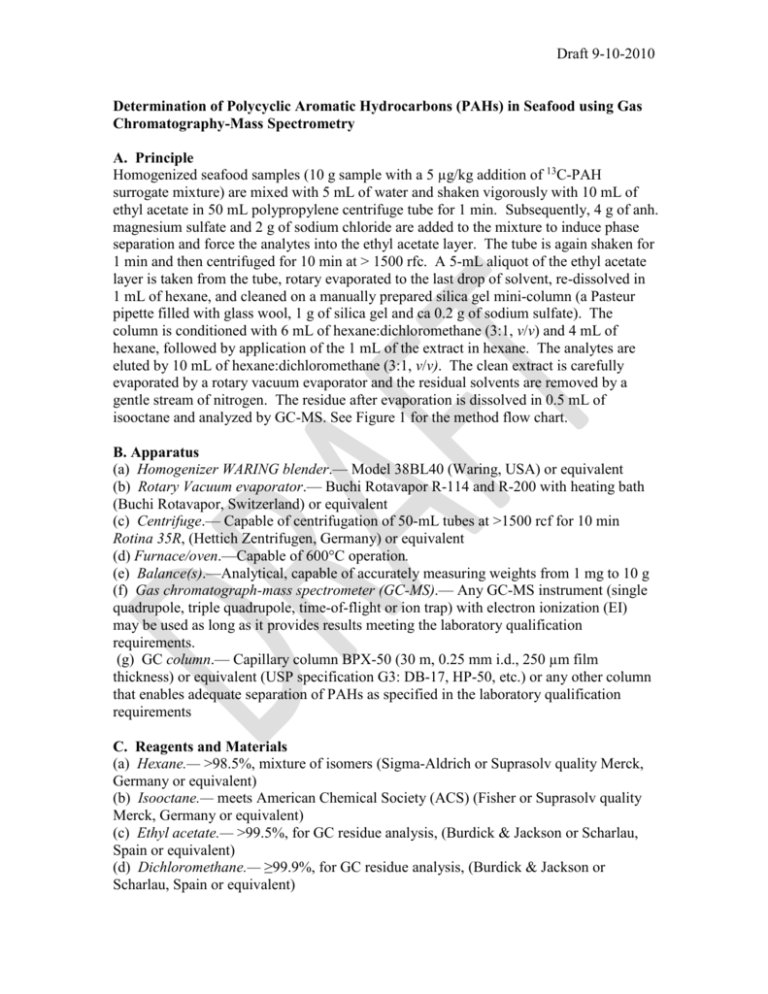
Draft 9-10-2010 Determination of Polycyclic Aromatic Hydrocarbons (PAHs) in Seafood using Gas Chromatography-Mass Spectrometry A. Principle Homogenized seafood samples (10 g sample with a 5 µg/kg addition of 13C-PAH surrogate mixture) are mixed with 5 mL of water and shaken vigorously with 10 mL of ethyl acetate in 50 mL polypropylene centrifuge tube for 1 min. Subsequently, 4 g of anh. magnesium sulfate and 2 g of sodium chloride are added to the mixture to induce phase separation and force the analytes into the ethyl acetate layer. The tube is again shaken for 1 min and then centrifuged for 10 min at > 1500 rfc. A 5-mL aliquot of the ethyl acetate layer is taken from the tube, rotary evaporated to the last drop of solvent, re-dissolved in 1 mL of hexane, and cleaned on a manually prepared silica gel mini-column (a Pasteur pipette filled with glass wool, 1 g of silica gel and ca 0.2 g of sodium sulfate). The column is conditioned with 6 mL of hexane:dichloromethane (3:1, v/v) and 4 mL of hexane, followed by application of the 1 mL of the extract in hexane. The analytes are eluted by 10 mL of hexane:dichloromethane (3:1, v/v). The clean extract is carefully evaporated by a rotary vacuum evaporator and the residual solvents are removed by a gentle stream of nitrogen. The residue after evaporation is dissolved in 0.5 mL of isooctane and analyzed by GC-MS. See Figure 1 for the method flow chart. B. Apparatus (a) Homogenizer WARING blender.— Model 38BL40 (Waring, USA) or equivalent (b) Rotary Vacuum evaporator.— Buchi Rotavapor R-114 and R-200 with heating bath (Buchi Rotavapor, Switzerland) or equivalent (c) Centrifuge.— Capable of centrifugation of 50-mL tubes at >1500 rcf for 10 min Rotina 35R, (Hettich Zentrifugen, Germany) or equivalent (d) Furnace/oven.—Capable of 600°C operation. (e) Balance(s).—Analytical, capable of accurately measuring weights from 1 mg to 10 g (f) Gas chromatograph-mass spectrometer (GC-MS).— Any GC-MS instrument (single quadrupole, triple quadrupole, time-of-flight or ion trap) with electron ionization (EI) may be used as long as it provides results meeting the laboratory qualification requirements. (g) GC column.— Capillary column BPX-50 (30 m, 0.25 mm i.d., 250 µm film thickness) or equivalent (USP specification G3: DB-17, HP-50, etc.) or any other column that enables adequate separation of PAHs as specified in the laboratory qualification requirements C. Reagents and Materials (a) Hexane.— >98.5%, mixture of isomers (Sigma-Aldrich or Suprasolv quality Merck, Germany or equivalent) (b) Isooctane.— meets American Chemical Society (ACS) (Fisher or Suprasolv quality Merck, Germany or equivalent) (c) Ethyl acetate.— >99.5%, for GC residue analysis, (Burdick & Jackson or Scharlau, Spain or equivalent) (d) Dichloromethane.— ≥99.9%, for GC residue analysis, (Burdick & Jackson or Scharlau, Spain or equivalent) Draft 9-10-2010 (e) Acetone.— ≥99.9%, (Sigma or Penta Chrudim, Czech Republic or equivalent) (f) Water.— purified, free of interfering compounds (g) Anhydrous sodium sulfate (Na2SO4).—≥ 99.0%, powder (Sigma or Penta Chrudim, Czech Republic or equivalent). Heat at 600°C for 7 hours and then store in a desiccator before use. Na2SO4 prepared and stored as indicated can be used for one month from preparation. (h) Silica gel.— (Sigma or Merck, Germany or equivalent). Activate the silica gel by heating at 180°C for 5 hours, than deactivate it by adding 5% of deionized water, shaking for 3 hours and store in a desiccator for 16 hours before use. Silica gel prepared and stored as indicated can be used for 14 days. (i) Anhydrous magnesium sulfate (MgSO4).—≥ 99.0%, powder (Sigma-Aldrich, or equivalent).1 (j) Sodium chloride (NaCl).—≥ 99.0% (Sigma or Lach-ner, Czech Republic or equivalent)1 (k) Helium 5.0 or better, Nitrogen 4.0 or better.—(Siad, Czech Republic or equivalent) (l) Glass wool.— deactivated (Merck, Germany or equivalent) (m) Polypropylene tubes.—50 mL (Merci, France or equivalent) (n) Glass Pasteur pipette.—5 mL (Poulten and Graf GmgH, Germany or equivalent) (o) Syringes/pipettes. - Capable of accurate measurement and transfer of appropriate volumes for standard solution preparation and sample fortification (50-1000 μL) (p) Volumetric flasks.— 5-100 mL (q) Round-bottom flasks.— 25 or 50 mL 1 Note: A pre-weighed mixture of 2 g of sodium chloride and 4 g anh. magnesium sulfate (muffled) in pouches or tubes can be used, such as ECQUUS2-MP product from UCT or equivalent. D. Reference Standards (a) Anthracene.—Product No. 31581-250MG, Sigma or equivalent (b) Benz(a)anthracene.— Product No. B2209-500MG, Sigma or equivalent (c) Benzo(a)pyrene.— Product No. 48564, Sigma or equivalent (d) Benzo(b)fluoranthene.— Product No. 275336-100MG, Sigma or equivalent (e) Benzo(g,h,i)perylene.— Product No. C 20630000, EQ Labs or equivalent (f) Benzo(k)fluoranthene.— Product No. 392251-100MG, Sigma or equivalent (g) Chrysene.— Product No. 35754-100MG, Sigma or equivalent (h) Dibenz(a,h)anthracene.— Product No. 48574, Sigma or equivalent (i) Fluoranthene.— Product No. O-785, ChemService or equivalent (j) Fluorene.— Product No. O-786, ChemService or equivalent (k) Indeno(1,2,3-cd)pyrene.— Product No. 48499, Sigma or equivalent (l) Naphthalene.— Product No. O-789, ChemService or equivalent (m) Phenanthrene.— Product No. 695114-1G, Sigma or equivalent (n) Pyrene.— Product No. 571245-1G, Sigma or equivalent (o) 1-Methylnaphthalene.— Product No. 0712.11-10MG, Chiron or equivalent (p) 2,6-Dimethylnaphthalene.— Product No. 126535-1G, Sigma or equivalent (q) 1-Methylphenanthrene.— Product No. 0811.15-K-IO (1000 µg/mL, 1 mL), Chiron or equivalent Draft 9-10-2010 (r) 1,7-Dimethylphenanthrene.— Product No. 1693.16-500-IO (500 µg/mL, 1 mL), Chiron or equivalent (s) 3-Methylchrysene.— Product No. BCR-079R, Chiron or equivalent (t) US EPA 16 PAH Cocktail.—(13C, 99%), Product No. ES-4087 (5 µg/mL, 1.2 mL in nonane), Cambridge Isotope Labs or equivalent Containing: Acenaphthene (13C6,99%), Acenaphthylene (13C6,99%), Anthracene (13C6,99%), Benz[a]anthracene (13C6,99%), Benzo[b]fluoranthene (13C6,99%), Benzo[k]fluoranthene (13C6,99%), Benzo[g,h,i]perylene (13C12,99%), Benzo[a]pyrene (13C4,99%), Chrysene (13C6,99%), Dibenz[a,h]anthracene (13C6,99%), Fluoranthene (13C6,99%), Fluorene (13C6,99%), Indeno[1,2,3-cd]pyrene (13C6,99%), Naphthalene (13C6,99%), Phenanthrene (13C6,99%), Pyrene (13C6,99%) E. Preparation of Standard Solutions (a) Individual Stock Solutions.— Prepare individual PAH stock solutions at approx. 1000 or 2500 µg/mL in toluene using neat reference standards or obtain as solutions as indicated above for 1-methylphenantherene and 1,7-dimethylphenanthrene. (b) Mixed Stock Standard Solution.— Use analyte individual stock solutions to obtain a mixed solution of each PAH at 10 µg/mL (for BaP and other low-level PAHs) or 25 µg/mL (for chrysene and other higher-level PAHs) in isooctane. See Table 1 for analyte concentrations in the Mixed Stock Standard Solution. (c) Working PAH Solution A — Accurately transfer 0.5 mL of the Mixed Stock Standard Solution into 5-mL volumetric flask and dilute to volume with isooctane. (d) Working PAH Solution B — Accurately transfer 0.5 mL of the Working PAH Solution A into 5-mL volumetric flask and dilute to volume with isooctane. (e) Internal Standard Solution — Prepare 1 µg/mL solution of 13C-PAHs in isooctane by 5-fold dilution of the 5 µg/mL EPA 16 13C-PAHs cocktail with isooctane. (f) Calibration Standard Solutions — Prepare eight levels of calibration standard solutions (1 mL each) in 2-mL amber screw-cap vials. See Table 2 for analyte concentrations in the calibration standards and Table 3 for the dilution scheme. 1. For level 1 calibration standard – Accurately transfer 50 µL of the Working PAH Solution B into the vial and add 50 µL of the 1 µg/mL 13C-PAHs solution and 900 µL of isooctane. Cap the vial and vortex mix briefly. 2. For level 2 calibration standard – Accurately transfer 100 µL of the Working PAH Solution B into the vial and add 50 µL of the 1 µg/mL 13C-PAHs solution and 850 µL of isooctane. Cap the vial and vortex mix briefly. 3. For level 3 calibration standard – Accurately transfer 200 µL of the Working PAH Solution B into the vial and add 50 µL of the 1 µg/mL 13C-PAHs solution and 750 µL of isooctane. Cap the vial and vortex mix briefly. Draft 9-10-2010 4. For level 4 calibration standard – Accurately transfer 500 µL of the Working PAH Solution B into the vial and add 50 µL of the 1 µg/mL 13C-PAHs solution and 450 µL of isooctane. Cap the vial and vortex mix briefly. 5. For level 5 calibration standard – Accurately transfer 100 µL of the Working PAH Solution A into the vial and add 50 µL of the 1 µg/mL 13C-PAHs solution and 850 µL of isooctane. Cap the vial and vortex mix briefly. 6. For level 6 calibration standard – Accurately transfer 200 µL of the Working PAH Solution A into the vial and add 50 µL of the 1 µg/mL 13C-PAHs solution and 750 µL of isooctane. Cap the vial and vortex mix briefly. 7. For level 7 calibration standard – Accurately transfer 500 µL of the Working PAH Solution A into the vial and add 50 µL of the 1 µg/mL 13C-PAHs solution and 450 µL of isooctane. Cap the vial and vortex mix briefly. 8. For level 8 calibration standard – Accurately transfer 100 µL of the Mixed Stock Standard Solution into the vial and add 50 µL of the 1 µg/mL 13C-PAHs solution and 850 µL of isooctane. Cap the vial and vortex mix briefly. F. Extraction and Clean-up Procedure 1) Add 50 µL of the 1 µg/mL 13C-PAHs solution to 10±0.1 g of thoroughly homogenized fish or seafood sample in a 50-mL polypropylene centrifuge tube. 2) Vortex sample for 15 s and let equilibrate for 15 min. 3) Add 5 mL of purified water and 10 mL of ethyl acetate. 4) Shake the tube vigorously by hand for 1 min. 5) Add 4 g of anhydrous magnesium sulfate and 2 g of sodium chloride and seal the tube well (ensure that powder does not get into the screw threads or rim of the tube). 6) Shake the tube vigorously by hand for 1 min, ensuring that crystalline agglomerates are broken up sufficiently during shaking. 7) Centrifuge the tube at > 1,500 rcf for 10 minutes. 8) Take a 5-mL aliquot of the upper ethyl acetate layer, place it in a small (25- or 50-mL) round-bottom flask and rotary evaporate to the last drop of solvent. 9) Reconstitute in 1 mL of hexane. 10) Condition a manually prepared silica gel mini-column (a Pasteur pipette filled with a piece of glass wool, 1 g of silica gel and approx. 0.2 g of anh. sodium sulfate) with 6 mL of hexane:dichloromethane (3:1, v/v) and 4 mL of hexane. 11) Apply the 1 mL of the extract in hexane. 12) Elute with 10 mL of hexane:dichloromethane (3:1,v/v) and collect the eluent in a small (25- or 50-mL) round-bottom flask. 13) Gently evaporate the eluent to dryness by rotary evaporation to the last drop of solvent, followed by removal the residual solvent with a gentle stream of nitrogen. 14) Reconstitute in 0.5 mL isooctane. NOTE: The fat capacity of the 1-g silica gel mini-column is 0.1 g. If the 5-mL ethyl acetate extract aliquot contains more than 0.1 g of fat, it is necessary to use a smaller aliquot volume to avoid sample breakthrough during the clean-up step. Draft 9-10-2010 G. GC-MS Analysis (a) GC conditions.— Table 4 gives an example of GC conditions for the analysis of PAHs (see Figure 2 for a chromatogram example). Other conditions (e.g. column, temperature and flow program, injection technique and volume) can be used as long as the laboratory qualification criteria for separation, sensitivity and linearity are met. Conduct proper inlet and column maintenance to ensure adequate operation of the GC instrument. Perform system checks. (b) MS conditions.— Any GC-MS instrument (single quadrupole, triple quadrupole, time-of-flight or ion trap) with electron ionization (EI) may be used as long as it provides results meeting the laboratory qualification requirements. Table 5 provides MS ions (m/z) suggested for quantification and identification of target PAHs and 13C-PAHs using single-stage MS instruments. Table 6 provides MS-MS transitions suggested for quantification and identification of target PAHs and 13C-PAHs using tandem MS instruments (optimum collision energies have to be determined). Use adequate data acquisition rate (dwell times in scanning instruments) and solvent delay time. Perform air/water checks and autotune to verify and obtain adequate operation of the instrument. Verify identification of the analyte peaks by comparing the ion ratios of contemporaneously analyzed calibration standards which have been analyzed under the same conditions. For each analyte, the target sample relative abundance is ±20% (arithmetic difference) of the target relative abundance. (c) Injection Sequence.—For an analytical run, bracket the seven test samples with two sets of calibration standards. Inject solvent blanks after the calibration level 8 (highest) standard and after the samples. In addition, analyze a reagent blank with each set of samples. H. Calculation Quantitation is based on linear least-squares calibration of analyte signals (SPAH) divided by signals (S13C-PAH) of corresponding 13C-labelled internal standards (see Table 7) plotted versus analyte concentrations. Peak areas are generally preferred as signals used for the quantitation but peak heights should be used for peaks that are not well resolved, such as in the case of anthracene and phenanthrene. The analyte concentrations in the final extract (cPAH, µg/L) are determined from the equation: cPAH = [(SPAH / S13C-PAH) - b] / a, where a is the slope of the calibration curve and b is the y-intercept. The concentration of PAHs in the sample (C, µg/kg) is then calculated: C = (cPAH / c13C-PAH) × (X13C-PAH / m), where c13C-PAH is the concentration of the corresponding 13C-PAH in the calibration standard solutions (in µg/L); X13C-PAH is the amount of the corresponding 13C-PAH added to the sample (in ng); and m is the sample weight (in g). Based on the method procedure Draft 9-10-2010 and preparation of the calibration standard solutions, c13C-PAH is 50 µg/L, X13C-PAH is 50 ng and m for the test samples is 10 g. Eight concentration levels will be used for the calibration, corresponding to 5, 10, 20, 50, 100, 200, 500 and 1000 µg/L for BaP and other lower-level PAHs and to 12.5, 25, 50, 125, 250, 500, 1250 and 2500 µg/L for higher-level PAHs. Coefficients of determination (r2) should be 0.990 or greater and back-calculated concentrations of the calibration standards should not exceed ±20% of theoretical. If a well-characterized quadratic relationship occurs, then a best-fitted quadratic curve may be employed for calibration. Otherwise, if the back-calculated concentrations exceed ±20% of theoretical, normalized signals of the nearest 2 calibration standards that enclose the analyte signal in the sample will be used to interpolate the analyte concentration in the final extract. Draft 9-10-2010 Table 1. Analyte concentrations in the Mixed Stock Standard Solution Analyte Anthracene Benz(a)anthracene Benzo(a)pyrene Benzo(b)fluoranthene Benzo(g,h,i)perylene Benzo(k)fluoranthene Chrysene Dibenz(a,h)anthracene Fluoranthene Fluorene Indeno(1,2,3-cd)pyrene Naphthalene Phenanthrene Pyrene 1-Methylnaphthalene 2,6-Dimethylnaphthalene 1-Methylphenanthrene 1,7-Dimethylphenanthrene 3-Methylchrysene Concentration (µg/mL) 10 10 10 10 10 10 25 10 25 10 10 25 25 25 25 25 25 10 25 Draft 9-10-2010 Table 2. PAH and 13C-PAH concentrations in the calibration standard solutions Concentration in µg/L Equivalent concentration in µg/kg 13 13C-PAHs Calibration BaP and Chr and C-PAHs BaP and Chr and 1 2 1 2 Level others others others others 5 1 5 12.5 50 0.5 1.25 5 2 10 25 50 1 2.5 5 3 20 50 50 2 5 5 4 50 125 50 5 12.5 5 5 100 250 50 10 25 5 6 200 500 50 20 50 5 7 500 1250 50 50 125 5 8 1000 2500 50 100 250 1 Analytes at 10 µg/mL in the Mixed Stock Standard Solution. 2 Analytes at 25 µg/mL in the Mixed Stock Standard Solution. Table 3. Dilution scheme for preparation of the calibration standard solutions Volume of Volume of Mixed Stock Working Standard PAH Calibration Solution Solution A Level (µL) (µL) 1 2 3 4 100 5 200 6 500 7 100 8 1 Bring to volume using isooctane. Volume of Working PAH Solution B (µL) 50 100 200 500 - Volume of 13 C-PAH 1 µg/mL solution (µL) 50 50 50 50 50 50 50 50 Final Volume1 (µL) 1000 1000 1000 1000 1000 1000 1000 1000 Draft 9-10-2010 Table 4. Example of GC conditions for the analysis of PAHs Column Oven temperature program Carrier gas (helium) flow Injection technique Injection volume Vent time Vent flow Vent pressure Inlet temperature program BPX-50 (30 m x 0.25 mm i.d. x 0.25 µm film thickness) 80°C (hold for 4.3 min), 30°C/min to 220°C, 2°C/min to 240°C, and 10°C/min to 360°C (hold for 17 min) 1.3 mL/min (hold for 19 min), then 50 mL/min to 2 mL/min (hold for 16 min) PTV solvent vent 1x8 µL 2.3 min 50 mL/min 50 psi 50°C (hold for 2.3 min), then 400°C/min to 300°C Draft 9-10-2010 Table 5. MS ions (m/z) suggested for quantification and identification of target PAHs and 13C-PAHs using single-stage MS instruments Group PAHs 13 CPAHs Analyte Name Abbreviation anthracene benz[a]anthracene benzo[a] pyrene benzo[b]fluoranthene benzo[k]fluoranthene benzo[g,h,i]perylene chrysene dibenzo[a,h]anthracene fluoranthene fluorene indeno[1,2,3-cd]pyrene naphthalene phenanthrene pyrene 3-methylchrysene 1-methylnaphthalene 1-methylphenanthrene 2,6-Dimethylnaphthalene 1,7-Dimethylphenanthrene Naphthalene (13C6) Fluorene (13C6), Phenanthrene (13C6) Anthracene (13C6) Fluoranthene (13C6) Pyrene (13C6) Benz[a]anthracene (13C6) Chrysene (13C6) Benzo[b]fluoranthene (13C6) Benzo[k]fluoranthene (13C6) Benzo[a]pyrene (13C4) Indeno[1,2,3-cd]pyrene (13C6) Dibenz[a,h]anthracene (13C6) Benzo[g,h,i]perylene (13C12) Ant BaA BaP BbF BkF BghiP Chr DBahA Flt Fln IcdP Naph Phe Pyr 3-MC 1-MN 1-MP 2,6-DMN 1,7-DMP Naph- 13C6 Fln- 13C6 Phe- 13C6 Ant- 13C6 Flt-13C6 Pyr-13C6 BaA- 13C6 Chr- 13C6 BbF- 13C6 BkF- 13C6 BaP- 13C4 IcdP- 13C6 DBahA- 13C6 BghiP- 13C12 Confirmation Quantitation Ions (m/z) Ions (m/z) 177 178 226 228 253 252 253 252 253 252 277 276 226 228 276 278 200 202 165 166 277 276 127 128 177 178 200 202 241 242 115 142 189 192 141 156 191 206 136 137 171 172 183 184 183 184 205 208 208 205 232 234 232 234 259 258 259 258 257 256 283 282 282 284 289 288 Draft 9-10-2010 Table 6. MS-MS transitions suggested for quantification and identification of target PAHs and 13C-PAHs using tandem MS instruments Group PAHs 13 CPAHs Analyte Name Abbreviation anthracene benz[a]anthracene benzo[a] pyrene benzo[b]fluoranthene benzo[k]fluoranthene benzo[g,h,i]perylene chrysene dibenzo[a,h]anthracene fluoranthene fluorene indeno[1,2,3-cd]pyrene naphthalene phenanthrene pyrene 3-methylchrysene 1-methylnaphthalene 1-methylphenanthrene 2,6-Dimethylnaphthalene 1,7-Dimethylphenanthrene Naphthalene (13C6) Fluorene (13C6), Phenanthrene (13C6) Anthracene (13C6) Fluoranthene (13C6) Pyrene (13C6) Benz[a]anthracene (13C6) Chrysene (13C6) Benzo[b]fluoranthene (13C6), Benzo[k]fluoranthene (13C6) Benzo[a]pyrene (13C4) Indeno[1,2,3-cd]pyrene (13C6) Dibenz[a,h]anthracene (13C6) Benzo[g,h,i]perylene (13C12) Ant BaA BaP BbF BkF BghiP Chr DBahA Flt Fln IcdP Naph Phe Pyr 3-MC 1-MN 1-MP 2,6-DMN 1,7-DMP Naph- 13C6 Fln- 13C6 Phe- 13C6 Ant- 13C6 Flt-13C6 Pyr-13C6 BaA- 13C6 Chr- 13C6 BbF- 13C6 BkF- 13C6 BaP- 13C4 IcdP- 13C6 DBahA- 13C6 BghiP- 13C12 Confirmation Quantitation Ions (m/z) Ions (m/z) 178>151 178>176 229>227 228>226 250>248 252>250 250>248 252>250 250>248 252>250 274>272 276>274 226>224 228>226 139>138 278>276 203>201 202>200 165>164 166>165 274>272 276>274 128>127 128>102 178>177 175>152 200>199 202>200 141>115 142>141 Draft 9-10-2010 Table 7. List of PAH analytes and corresponding 13C-PAHs suggested for PAH signal normalization Analyte Anthracene Benz(a)anthracene Benzo(a)pyrene Benzo(b)fluoranthene Benzo(g,h,i)perylene Benzo(k)fluoranthene Chrysene Dibenz(a,h)anthracene Fluoranthene Fluorene Indeno(1,2,3-cd)pyrene Naphthalene Phenanthrene Pyrene 1-Methylnaphthalene 2,6-Dimethylnaphthalene 1-Methylphenanthrene 1,7-Dimethylphenanthrene 3-Methylchrysene 13C-PAH used for signal normalization Anthracene (13C6) Benz[a]anthracene (13C6) Benzo[a]pyrene (13C4) Benzo[b]fluoranthene (13C6) Benzo[g,h,i]perylene (13C12) Benzo[k]fluoranthene (13C6) Chrysene (13C6) Dibenz[a,h]anthracene (13C6) Fluoranthene (13C6) Fluorene (13C6) Indeno[1,2,3-cd]pyrene (13C6) Naphthalene (13C6) Phenanthrene (13C6) Pyrene (13C6) Naphthalene (13C6) Naphthalene (13C6) Phenanthrene (13C6) Phenanthrene (13C6) Chrysene (13C6) Draft 9-10-2010 Homogenization of sample Liquid Extraction Weigh 10 g sample in PE tube and add 13C-PAHs Vortex sample (15 seconds) Equilibrate 15 minutes Add 5 mL H2O and 10 mL EtOAC Shake 1 minute 1. 2. 3. 4. 5. Partition 1. 2. 3. 4. 5. Add 4 g MgSO4 and 2 g NaCl Shake (1 minute) Centrifuge (> 1500 rfc for 10 min) Evaporate 5 mL aliquot of extract Reconstitute in 1 mL hexane Aliquot 5 ml of EtOAc = 5 g of matrix Aliquot depends on the fat content Clean-up on Silica gel mini-column (1g) 1. Condition mini-column with 6 mL Hex:DCM (3:1,v/v) and 4 mL Hex 2. Apply sample 3. Elute with 10 mL of Hex:DCM (3:1,v/v) Concentration 1. Gently evaporate to dryness 2. Reconstitute in 0.5 mL isooctane GC-MS analysis Hex – hexane, DCM – dichloromethane, EtOAc – ethyl acetate Figure 1. Method flow chart Draft 9-10-2010 4 60000 3 12 50000 15 +16 8 9 5 6 25 10 11 26 40000 24 30000 20 21 22 23 13 14 12 17 19 20000 18 27 28 30 7 10000 29 0 T ime (s) 128 302 750 142 152 1000 153 166 1250 178 1500 202 216 1750 226 2000 228 242 2250 252 2500 276 Figure 2. An example chromatogram of a GC separation of PAHs and their alkyl homologues in a standard solution mixture at 25 ng/mL in isooctane 1 - Naph, 2 – 1-MeNaph, 3 – 2-MeNaph, 4 – Acy, 5 – Ace, 6 – Fln, 7 – DBT, 8 – Phe, 9 – Ant, 10 – Flt, 11 – Pyr, 12 – 1-MePyr, 13 – BcFln, 14 – BaA, 15 – CPcdP, 16 – Chr, 17 – 1-MeChr, 18 – 5-MeChr, 19 – 3-MeChr, 20 – BbF, 21 – BkF, 22 – BjF, 23 – BaP, 24 – DBahA, 25 – IcdP, 26 – BghiP, 27 – DBalP, 28 – DBaeP, 29 – DBaiP, 30 – DbahP, 31 – 1-MePhe, 32 – 2-MeAnt 278
